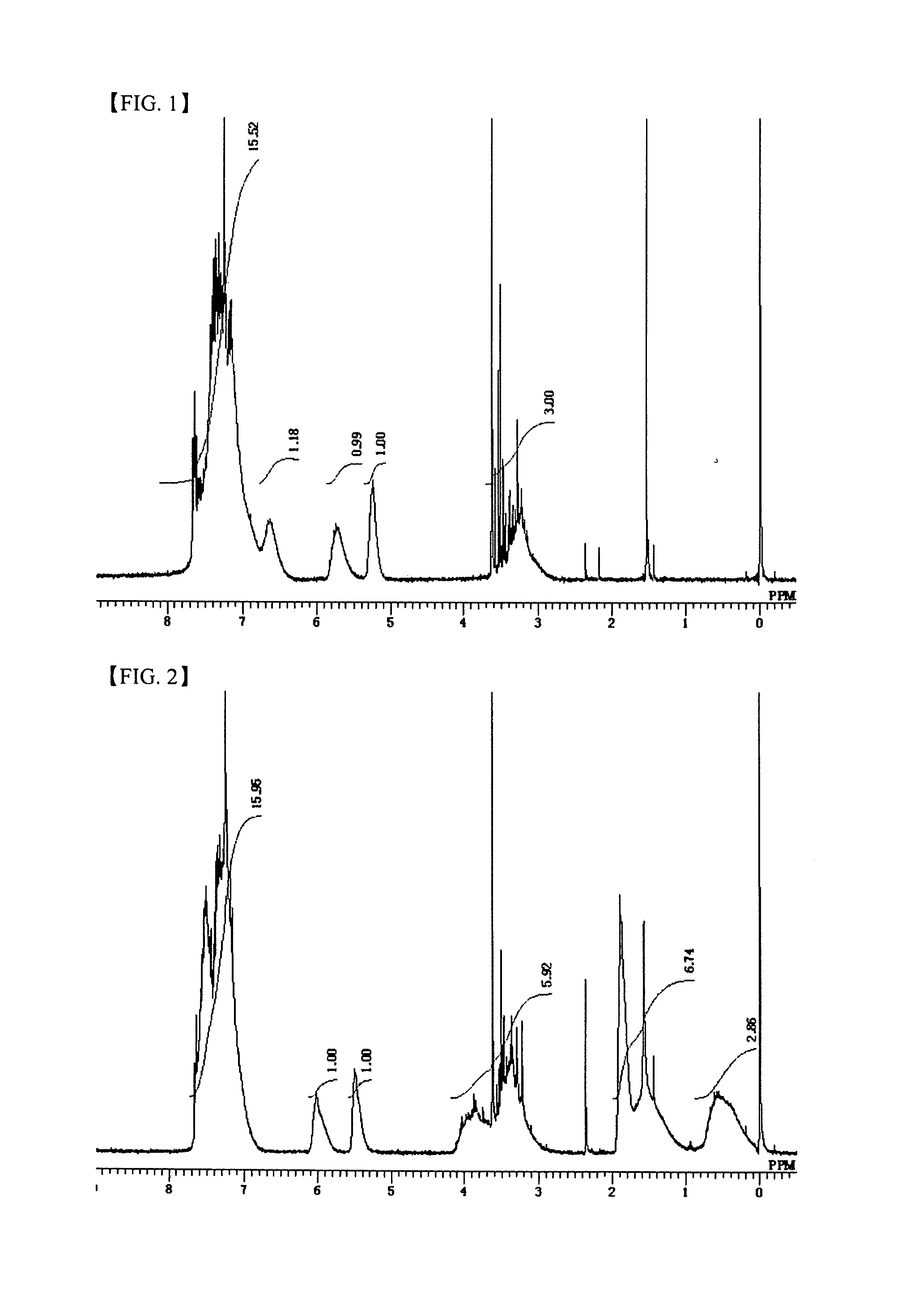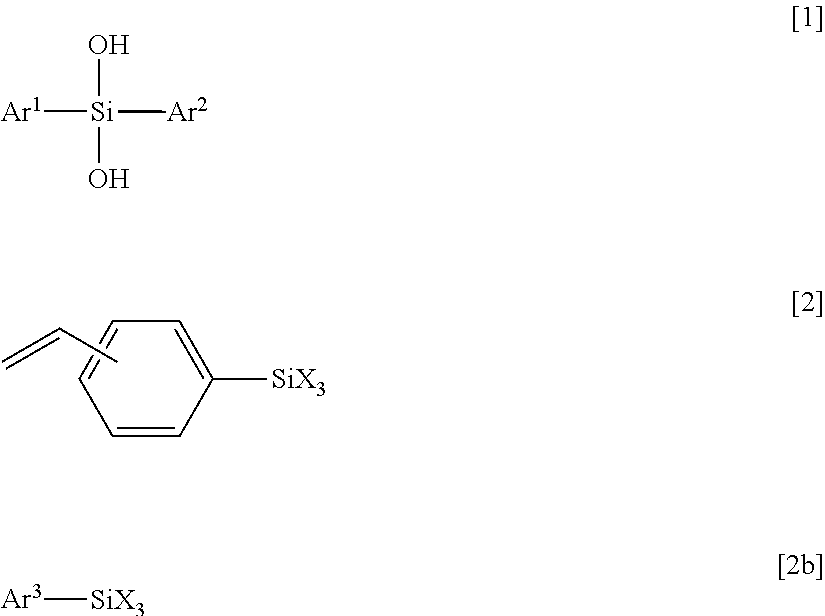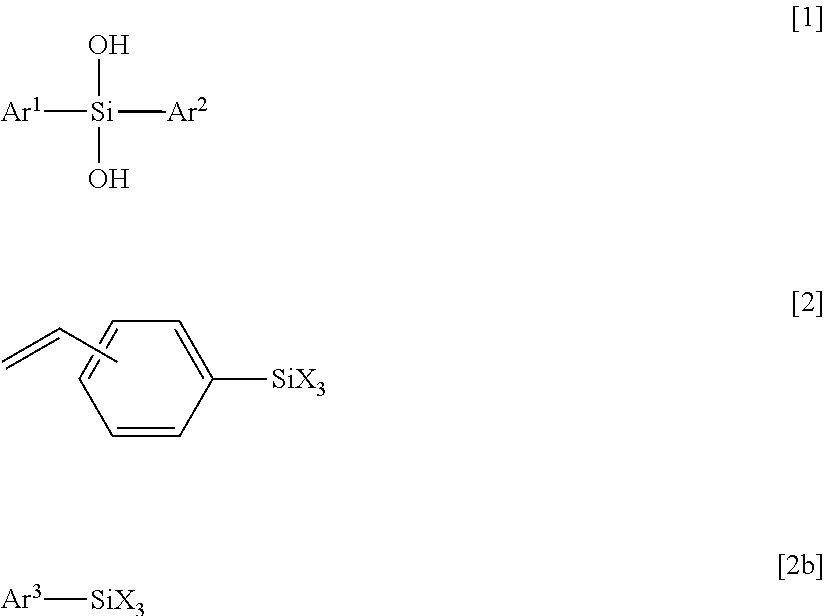Polymerizable compositions, cured products obtained therewith, and use of these materials
- Summary
- Abstract
- Description
- Claims
- Application Information
AI Technical Summary
Benefits of technology
Problems solved by technology
Method used
Image
Examples
synthesis example 1
[0130]A 1000 ml eggplant-shaped flask was charged with 0.80 mol (177 g) of diphenylsilanediol (manufactured by TOKYO CHEMICAL INDUSTRY CO., LTD), 0.80 mol (179 g) of styryltrimethoxysilane (manufactured by Shin-Etsu Chemical Co., Ltd.) and toluene (141 g) as a solvent. A condenser was attached to the eggplant flask, the inside of the flask was made to be nitrogen atmosphere by using a nitrogen balloon, and then a temperature of the mixture was gradually increased in an oil bath from the room temperature to 50° C. After the temperature of the mixture was confirmed to be stable at 50° C., 0.0016 mol (0.303 g) of barium hydroxide monohydrate (manufactured by Aldrich) was added to the flask as a catalyst, and the mixture was subjected to dealcoholization condensation for two days while the temperature was maintained at 50° C. The mixture was cooled to the room temperature and was filtered through a membrane filter having a pore diameter of 0.2 μm. Once again, the temperature of the mixt...
synthesis example 2
[0132]A 200 ml eggplant-shaped flask was charged with 0.10 mol (21.6 g) of diphenylsilanediol (manufactured by TOKYO CHEMICAL INDUSTRY CO., LTD), 0.10 mol (24.8 g) of 3-methacryloxypropyltrimethoxysilane (manufactured by Shin-Etsu Chemical Co., Ltd.) and toluene (19.2 g) as a solvent. A condenser was attached to the eggplant flask, the inside of the flask was made to be nitrogen atmosphere by using a nitrogen balloon, and then a temperature of the mixture was gradually increased in an oil bath from the room temperature to 50° C. After the temperature of the mixture was confirmed to be stable at 50° C., 0.0002 mol (0.038 g) of barium hydroxide monohydrate (manufactured by Aldrich) was added to the flask as a catalyst and the mixture was subjected to dealcoholization condensation for two days while the temperature was maintained at 50° C. The mixture was cooled to the room temperature and was filtered through a membrane filter having a pore diameter of 0.2 μm. Once again, the temperat...
example 1
[0133]A 500 ml eggplant-shaped flask was charged with the reactive silicone compound 1 (100 g) obtained in Synthesis Example 1 and divinylbenzene (20 g) that was purified by distilling divinylbenzene (purity: 80%, manufactured by Nippon Steel Chemical Co., Ltd.) under reduced pressure in a range of 50° C. to 52° C. in 3 Torr (3.99966×102 Pa). The temperature of the mixture was increased to 40° C. in an oil bath. While the temperature was maintained at 40° C., the mixture was stirred to be a homogeneous liquid. Finally, the temperature was returned to the room temperature, and thus, a pale yellow transparent polymerizable composition was obtained.
[0134]In 100 parts by mass of the polymerizable composition thus obtained, 3 parts by mass of Lucirin TPO (2,4,6-trimethylbenzoyl diphenylphosphine oxide) manufactured by BASF was dissolved as a photopolymerization initiator with stirring to prepare a photosensitive resin composition.
[0135]The photosensitive resin composition was held betwee...
PUM
| Property | Measurement | Unit |
|---|---|---|
| Temperature | aaaaa | aaaaa |
| Temperature | aaaaa | aaaaa |
| Temperature | aaaaa | aaaaa |
Abstract
Description
Claims
Application Information
 Login to View More
Login to View More - Generate Ideas
- Intellectual Property
- Life Sciences
- Materials
- Tech Scout
- Unparalleled Data Quality
- Higher Quality Content
- 60% Fewer Hallucinations
Browse by: Latest US Patents, China's latest patents, Technical Efficacy Thesaurus, Application Domain, Technology Topic, Popular Technical Reports.
© 2025 PatSnap. All rights reserved.Legal|Privacy policy|Modern Slavery Act Transparency Statement|Sitemap|About US| Contact US: help@patsnap.com



